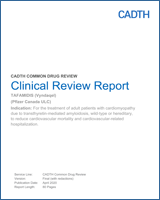Disease Background
ATTR-CM is a life-threatening, progressive disease that occurs in hereditary and wild-type forms. ATTR-CM occurs when TTR amyloid fibrils infiltrate the myocardium, leading to deposits of extracellular amyloid. This infiltration of the myocardium results in diastolic dysfunction progressing to restrictive cardiomyopathy, congestive heart failure and, ultimately, death.1,2,3 Symptoms of ATTR-CM are typical of restrictive cardiac disease and include dyspnea on exertion, orthostatic hypotension, and syncope, as well as conduction abnormalities, including bundle branch block, atrioventricular block, sinoatrial block, and atrial fibrillation.4,5 The mean progression to death for patients with ATTR-CM is within two to three years (median survival, 25.6 months) of diagnosis for the hereditary form and up to five years (median survival, 43.0 months) for the wild-type form,8 with most patients dying from cardiac causes, including sudden death, congestive heart failure, and myocardial infarction.1,2
Many of the manifestations of ATTR-CM are common with advancing age and not specific to ATTR-CM. As a result, ATTR-CM is often diagnosed only in later phases of disease when there is significant myocardial amyloid deposition and advanced restrictive cardiomyopathy. ATTR-CM is commonly underdiagnosed, as a definitive diagnosis occurs via histological confirmation of myocardial ATTR deposition through invasive cardiac biopsy.9 As cardiac biopsy is associated with a risk of fatal cardiac complications,10 the application of non-invasive imaging with nuclear scintigraphy has been used in the diagnostic pathway for patients with ATTR-CM.10–12 Objective measures of cardiac involvement include abnormal electrocardiogram, left and right ventricular wall thickening by echocardiogram, and elevated cardiac biomarkers such as NT-proBNP.4,5 These electrocardiogram, echocardiogram, and laboratory test findings are non-specific for heart failure, making the diagnosis of cardiac amyloidosis difficult and likely resulting in under diagnosis of this condition.13
The hereditary form is caused by genetic mutations that destabilize the TTR protein, which is produced predominantly in the liver and transports thyroxine and vitamin A in plasma.14 The natural state of the TTR protein is a tetramer; however, gene mutations can cause the protein to disassociate, misfold, and aggregate into amyloid fibrils that are deposited into various tissues in the body. More than 120 mutations of the TTR gene have been identified that produce various phenotypic presentations.15 The mutation that is most commonly associated with cardiomyopathy is V122I, but has low penetrance.15,16 The V30M mutation is most common outside of the US and causes a predominantly polyneuropathic manifestation, although it may also result in cardiomyopathy.15 The wild-type form of TTR is not associated with genetic mutations. It may result in amyloid deposits in tissues, causing an age-related amyloidosis, also known as senile systemic amyloidosis, that primarily affects men aged 60 years and older (later than hereditary forms).14 An autopsy study (N = 85) found that amyloid deposits were present in 25% of patients older than 85 years of age, although the clinical relevance of these deposits is unknown, as disease likely results only with severe and widespread infiltration.15 Clinically significant cardiac TTR amyloid may occur in 8% to 16% of people over 80 years of age.17 According to the clinical experts consulted by CADTH for this review, the prevalence of wild-type or hereditary AATR-CM is unknown in Canada.
Standards of Therapy
Treatment options that address the underlying disease process of ATTR-CM are limited. Both wATTR-CM and hATTR-CM are treated in a similar manner. Diflunisal is an NSAID that has been used as a TTR stabilizer, but there is limited evidence to support its use for ATTR-CM and it is not approved for this use in Canada.15 This drug also has a number of side effects that limit its use, particularly in patients with heart failure or renal impairment, which is common in ATTR-CM. Side effects include gastrointestinal ulceration and bleeding, altered renal function, renal decomposition, fluid retention, and precipitation of congestive heart failure.18 Heart or combined heart and liver transplantation is an option for hATTR-CM in younger patients (< 50 years); however, transplantation is associated with several complications, such as lack of donors, need for lifelong immunosuppression, and exclusion of older patients or those with advanced disease.15 Experimental treatments for ATTR-CM include doxycycline plus tauroursodeoxycholic acid in combination, or green tea extract (epigallocatechin-3-gallate [EGCG]). According to the clinical experts consulted by CADTH for this review, these treatments are rarely used in clinical practice and only by a few clinicians.15 Supportive treatments for cardiac disease (i.e., standard medications for arrhythmias or heart failure, such as diuretics) are important for the management of ATTR-CM. However, according to the clinical experts, supportive treatments are not as effective in patients with ATTR-CM and are associated with harms; therefore, the management of cardiac disease in this patient population is difficult.
Drug
Tafamidis meglumine is a small molecule that stabilizes the TTR protein in both the wild-type and hereditary forms of the disease. The indication is for the treatment of adult patients with cardiomyopathy due to ATTR, wild-type or hereditary, to reduce cardiovascular mortality and cardiovascular-related hospitalization.6 Tafamidis is available as a 20 mg capsule that is taken orally. The recommended dose of tafamidis meglumine is 80 mg (administered as four 20 mg capsules) taken orally once daily, with or without food. In this report, tafamidis refers to tafamidis meglumine.
The European Medicines Agency has approved tafamidis 20 mg once daily for the treatment of TTR amyloidosis in adult patients with stage 1 symptomatic polyneuropathy to delay peripheral neurologic impairment.19 The FDA approved tafamidis meglumine 80 mg and tafamidis 61 mg once daily (which is equivalent to tafamidis meglumine 80 mg) as a treatment for ATTR-CM.20

